The final article regarding my tips on Building an eWalk program focuses on analysis and intervention protocols and refining and revising the eWalk program. If you missed the first three articles, you can read them here.
Once you have established your eWalk protocols and implemented your eWalk program, you will be well served to establish clear and concise analysis and intervention procedures so that your eWalk data is actionable.
Mounds of data are useless if it does not provide insight to the user and result in actionable information for your teachers or your school. Also, legitimate practitioners are always refining and revising their craft. One of the primary goals of the eWalk program is to improve student achievement. Professional educators should be continuously reflecting on their practice and implementing procedures that allow for authentic revision of their program. It is our duty as educational leaders to ensure our program is as effective and efficient as possible.
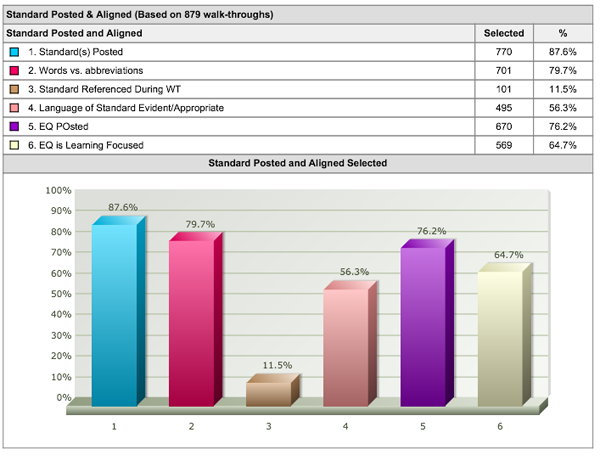
eWalk offers data reporting in a variety of formats for easy analysis.
Analysis and Intervention
a) Begin analysis early. Begin your initial analysis of eWalk data after week two – looking for patterns and trends. Ask yourself questions regarding your data. Does your data look as it should? Is it in the correct format? Is your data useful? Is your data measurable? If there are glowing concerns regarding your data or if your data does not appear to be useful, now is the time to make changes.
You certainly do not want to spend weeks gathering data that will not be useful.
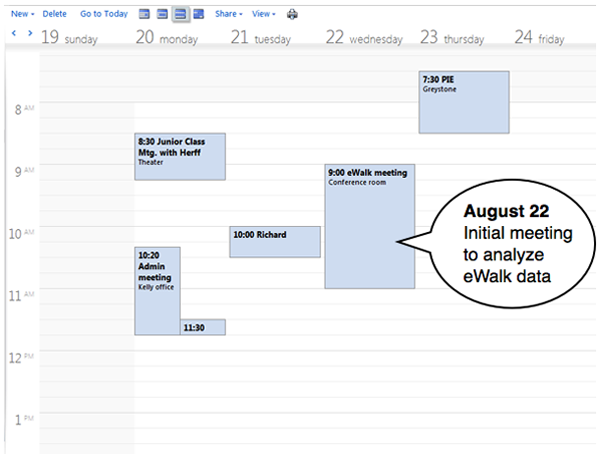
My calendar listing August 22, 2012 as the initial meeting to discuss early eWalk data.
b) Prepare for conversations. Prepare yourself for conversations with teachers. As teachers begin to receive completed walk-throughs with comments and feedback they will want to visit with you to ask questions or discuss their practice. Welcome these teachers with open arms as honest conversation is the most beneficial aspect of your eWalk program.
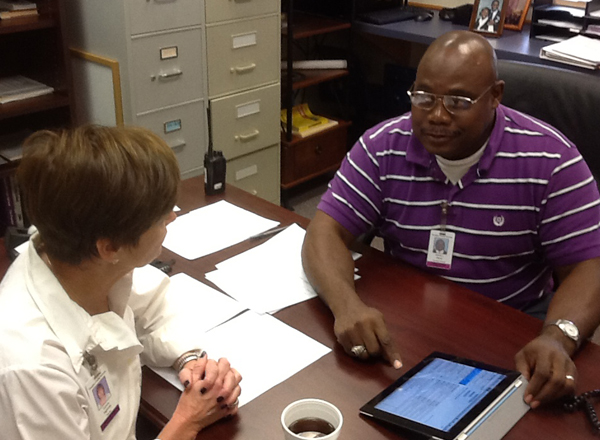
Assistant Principal Homer Hector discussing a walkthrough with teacher Connie Highnote.
c) Solicit reflection. Begin making comments to teachers that will solicit reflection. Asking teachers reflective questions will open the door to great conversations. Ask teachers how they felt about a lesson or how they felt students embraced the instructional strategies used to convey main ideas or concepts. Ask supportive questions of teachers that will encourage them to think about the lesson, the class, or the learning environment.
For example; Your EQ asks students to list the parts of a cell. How have you rephrased this type of question in the past to solicit a greater depth of knowledge?
d) Non-Invasive Interventions. After you have established the foundation of your walk-through process, you may want to consider initiating some non-invasive interventions for teachers that need a little support. You will do this in much the same manner you would with students.
When you identify an area of suggested growth during your walkthrough, provide some feedback to the teacher in the form of a guided question or a reflective statement. You ask the question or make a casual statement in a manner that leads the teacher in the direction you want them to go. While you are doing this please remember to formulate the question or the statement so that any negative perception by the teacher is minimized.
You are observing a Science class doing a lab on chemical reactions and you notice that a few students in the corner are not wearing their safety glasses. They have the glasses propped on their head and probably just forgot to lower the glasses over their eyes. The teacher quickly notices the students and appropriately redirects the students to the safety protocols for the class.
Your eWalk classroom walkthrough program has the power to transform your school. It certainly has transformed ours.
However, there was a brief amount of time where the students were not protected. On the walk-through you may offer a comment similar to this one, Students were participating in a lab that required strict safety protocols. I observed you quickly remind students of the appropriate use of safety glasses. I also observed your safety posters in your room reminding students of the importance of safety procedures during lab. What strategies have you implemented in addition to your posters and your verbal reminders to ensure students are practicing appropriate safety protocols during lab?
In this comment, I have communicated to the teacher that I did observe an issue regarding student safety. However, I focused most of my comment on the positive aspects of the teacher’s safety protocols and added a brief question at the end asking this teacher what additional steps are taken to remind students of safety requirements. I am attempting to focus on the positive aspects of the walkthrough while also soliciting some reflection from the teacher regarding what additional steps can be taken to prevent this type of incident from occurring again.
The walkthrough pictured below demonstrates positive comments in the three areas preceding student engagement. The students in this particular class were a little off task and seemed to be very relaxed regarding their assignment. However, students were working but not at the levels that are expected. This teacher is one of our best and usually has a very structured classroom. By making the “relaxed” comment, my goal was to solicit reflection from the teacher as to what were the students doing that would elicit such a comment from me. The teacher may or may not reflect on this comment but what I do not want to do in the early stages of the program is make a comment that would be perceived as negative. I would not provide a comment stating, “Your students were loud and off task resulting in a poor learning environment.”
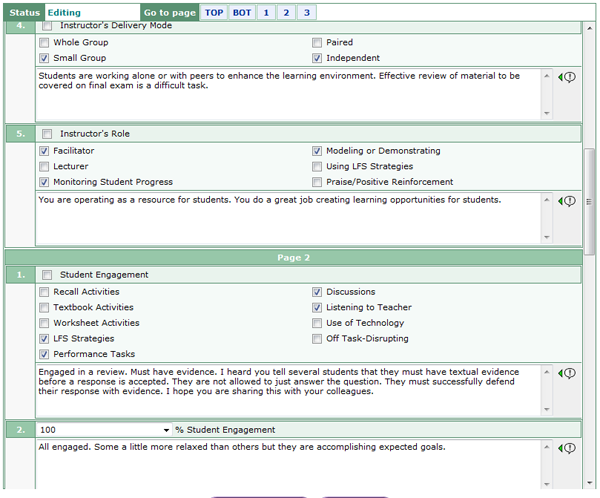
Three positive comments prior to a statement designed to praise students but also solicit reflection.
e) Avoid Issuing Directives. If at all possible and only in incidences where it is absolutely necessary I would suggest avoiding issuing directives to teachers. During the first year of your eWalk program, teachers will be apprehensive of the process. It will likely take at least a year or two before teachers feel very comfortable with your eWalk program. Issuing directives and telling teachers what they need to be doing in their classrooms with their students will likely be detrimental to your program. Teachers first need to trust that you have their best interests and the best interests of their students at heart before they will begin to fully participate in the walk-through process. Issuing directives to teachers early in the program will not build that trust.
Refine and Revise
a) Year One. The end of year one is an optimal time to reflect on your eWalk process and learn from your experiences. The end of a school year is a perfect time to reflect on your process as you have the summer to analyze your data and critique your program. As the current school year ends for us we have already scheduled our data review meeting. We will also relocate to our professional learning room so we can use our Promethean board to manipulate the data. We will take a critical look at our data and ask very specific questions. We will look at each template we use and each element contained in those templates.
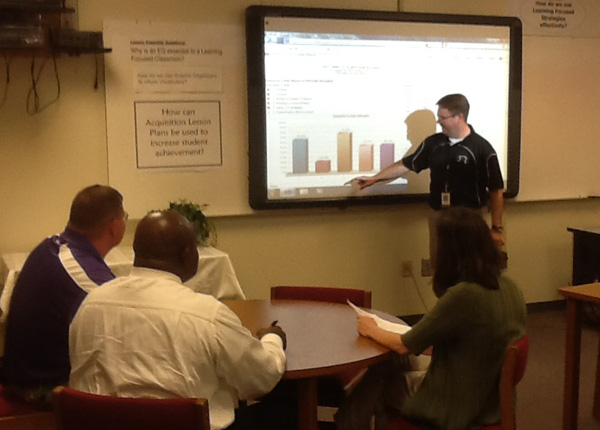
Administrative team meeting to analyze eWalk data for the school year.
b) Surveys. Consider surveying your teachers to solicit input from those who participate in your eWalk program. If you have implemented a strong program your teachers will be more likely to provide you with authentic feedback.
It has been my experience that teachers will appreciate you providing them opportunities to be fully involved in the process. Teachers will provide you with insight regarding the strengths and weaknesses of the program. They will tell you what they like and what they dislike about walkthroughs. The most revealing information teachers will provide you will be their suggestions on how to improve the program.
You can do many things with the information provided to you by teachers. The most important thing you will do with this information is demonstrate that you value the opinion of teachers and will use this feedback to improve the eWalk program. Nothing will jeopardize the trust of your teachers more than you demonstrating to them you do not value their opinion. Welcome open and honest feedback from your teachers and use that information to reflect on your process. Isn’t that what you are asking them to do? Don’t be hypocritical.
Nothing will jeopardize the trust of your teachers more than you demonstrating to them you do not value their opinion.
c) Meet With Your Team. Meet with your team and have discussions regarding your eWalk program over the last year. I have mentioned many times that our eWalk program is one of the most important things we do to improve our professional practice. A program of such importance demands our time and our full consideration as we look to continuously improve our ability to effectively serve our students. We will spend quality time and effort analyzing our data, reviewing our process, critiquing our practice, and improving our program. Each year we revise and refine our process to ensure our eWalk program and walk-through process is as effective and efficient as possible.
We will also discuss the accountability measures we have developed for the observation team. In our building the observation team consists of the five administrators. Our expectation is that each administrator will conduct at least ten walkthroughs per week providing meaningful feedback to teachers on most elements. We will look at our performance over the year and revise and refine our expectations as needed. We will also have discussions regarding our performance as it pertains to meeting or exceeding the expectations we have agreed upon.
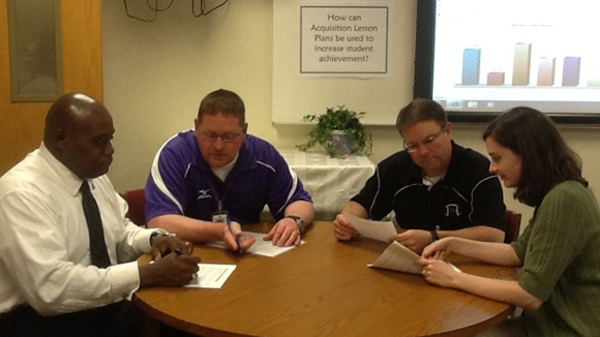
Administrative team discussing the eWalk program.
d) Continue eWalk Process. The next year of classroom visits, meaningful feedback, and continuous improvement will be exciting. Year two will reveal new opportunities for your eWalk program with new and exciting opportunities for your teachers. Your program has been in place for a year and teachers know what to expect and if you have implemented a solid program know they have a voice in the process. Continuously work to improve your process but please do not ever lose sight of the foundation of your program. The integrity of the program is based upon trust and a true desire to assist teachers in improving their professional practice so they may provide students with increased opportunities to be successful.
Your eWalk program evolves as you analyze data and implement new initiatives. You will discover patterns and trends that may result in an extension of your current process or lead you in an entirely new direction. The eWalk process is unique to your school or your district and can take any form you desire. Your eWalk program has the power to transform your school. It certainly has transformed ours.
If you have found this information to be useful, please leave a comment and let me know your opinions. If you have any suggestions or questions I would appreciate those as well.
If you have specific needs or if you would like more detailed information regarding the first year of using eWalk, please contact me at sean.kelly@douglas.k12.ga.us.
